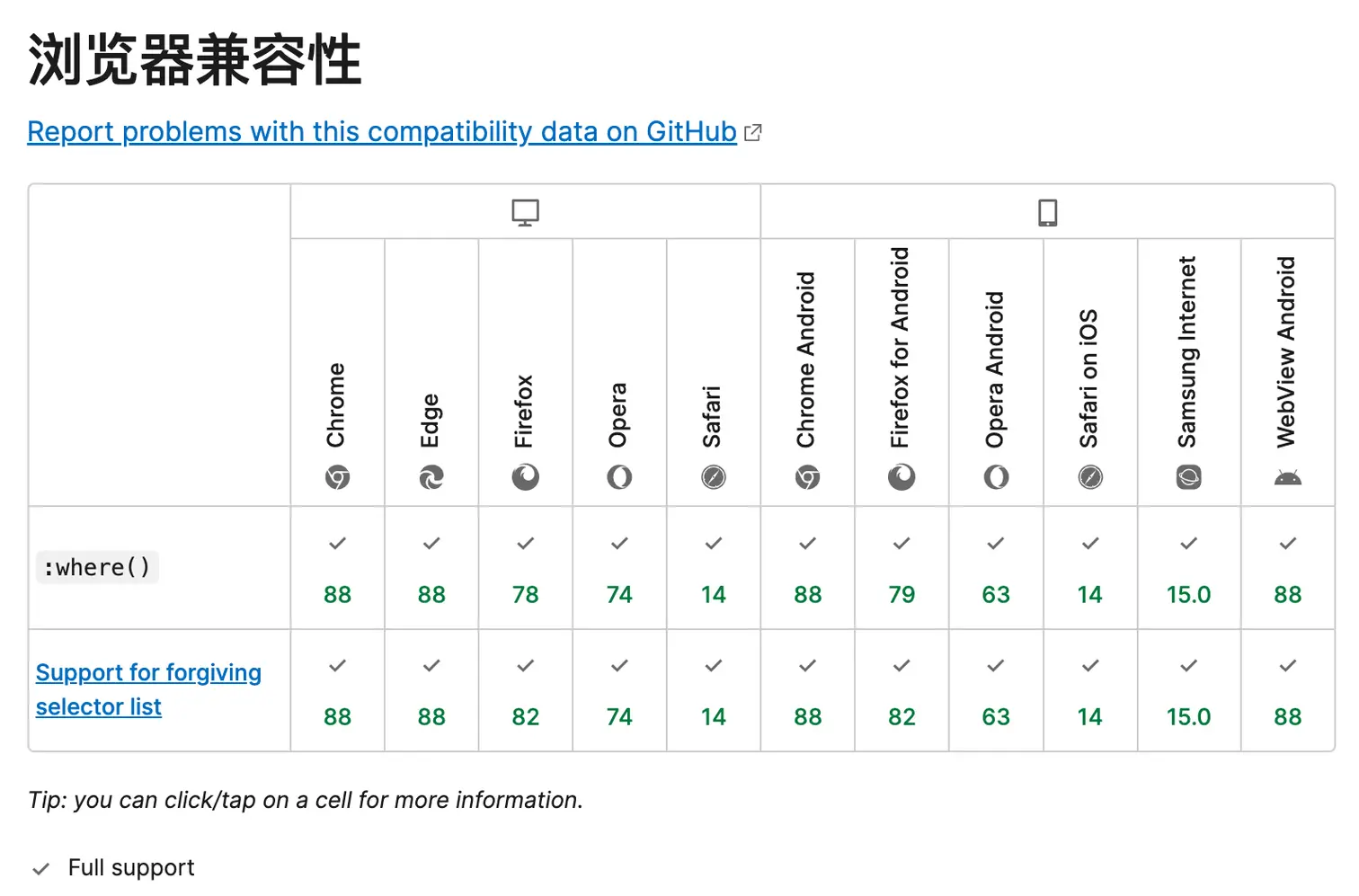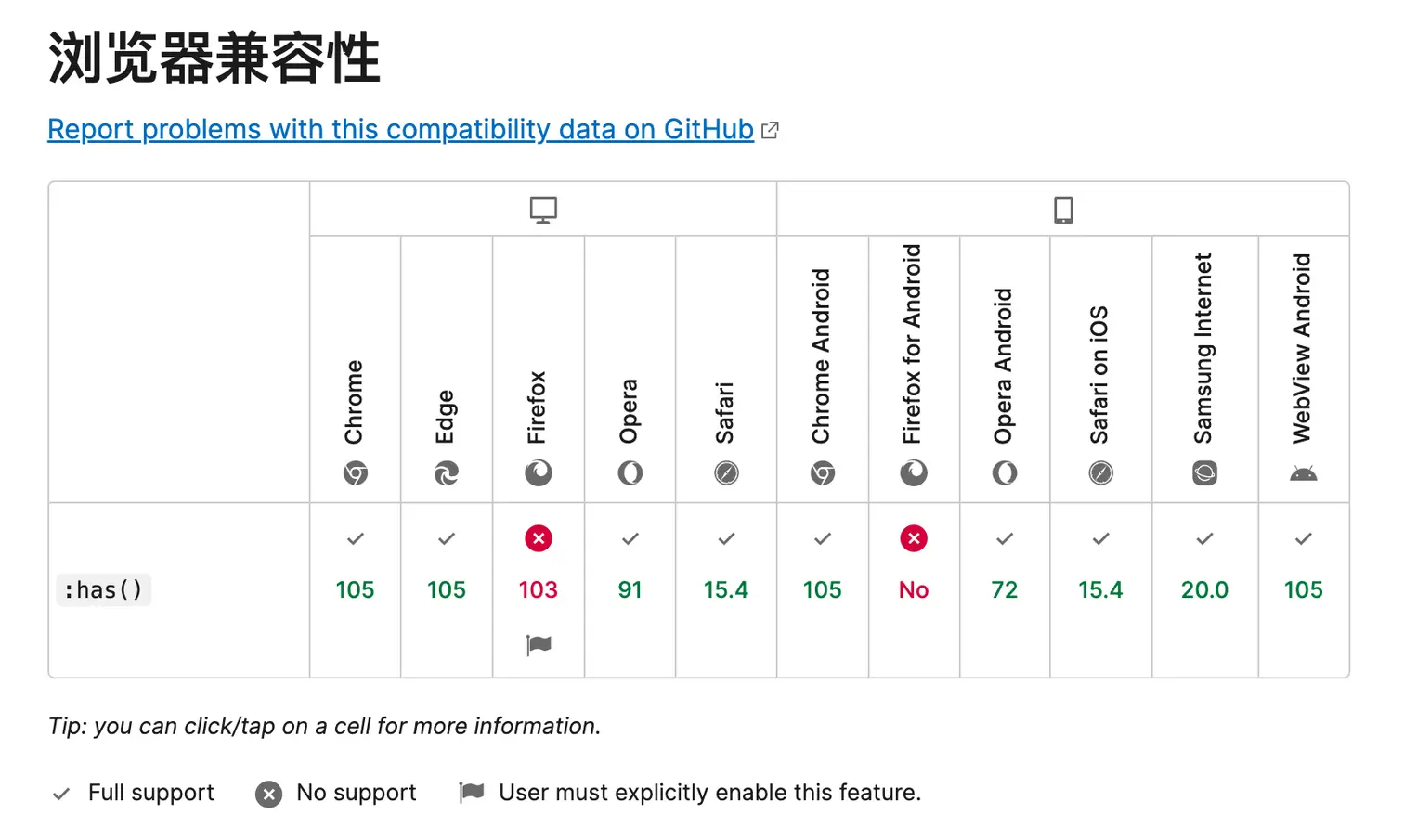:where
基本使用
:where() CSS 伪类函数接受选择器列表作为它的参数,将会选择所有能被该选择器列表中任何一条规则选中的元素。
以下代码,文本都会变成 yellow 颜色
:where(div p) span {color: yellow;
}<div class="test-div"><span>哈哈</span>
</div>
<p class="test-p"><span>哈哈</span>
</p>
使用场景
其实 :where() 的功能本来就有,只不过有了它之后,实现起这些功能来就更加方便快捷~接下来就来讲讲它的组合/叠加功能
我们来看下面的这段 css 代码
div a:hover,
li a:hover,
.cla a:hover,
.aa .bb a:hover,
[class^='bold'] a:hover{color: yellow;
}
我们可以使用 :where()来简化这个写法,使用它找出 div li .cla 这三种选择器,选择器可以是标签,也可以是类名,也可以是选择器表达式
:where(div, li, .cla, .a .b, [class^='bold']) a:hover {color: yellow;
}
再来看看使用 :where() 的组合,完成一些功能,我们看以下的代码
.dark-theme button,
.dark-theme a,
.light-theme button,
.light-theme a{color: pink;
}
我们完全可以使用 :where() 简化这个写法
:where(.dark-theme, light-theme) :where(button, a) {color: pink;
}
优先级
:where()的优先级是 0,我们可以看下面代码
.test {color: yellow;
}
:where(.test) {color: pink
}
最后字体颜色是 yellow
兼容性

:is
:is()跟:where()可以说一模一样,区别就是 :is()的优先级不是0,而是由传入的选择器来决定的,拿刚刚的代码来举个例子
div {color: yellow;
}
:where(.test) {color: pink
}<div class="test">哈哈</div>
这要是 :where(),那么字体颜色会是 yellow,因为它的优先级是 0
但是如果是 :is()的话,字体颜色会是 pink,因为 类选择器 优先级比 标签选择器 优先级高~
:is(.test) {color: pink
}
div {color: yellow;
}<div class="test">哈哈</div>
兼容性

:has
基本使用
举一个场景例子,我们看以下代码,一个容器中,图片是可以显隐的,我想要实现:
- 图片显示时,字体大小为 12px
- 图片隐藏时,字体大小为 20px
<div class="container">哈哈哈哈哈<img class="test-img" v-if="showImg"></img>
</div>
如果按照以前的做法,就是使用 动态class 的方式去玩完成这个功能,但是现在有 :has()可以通过 css 的方式去完成这件事~
.container {font-size: 20px;
}
.container:has(img) {font-size: 12px;
}或者
.container:has(.test-img) {font-size: 12px;
}
组合使用
现在又有两个场景
- 判断容器有没有子img,有的话字体设置为 12px(上面的例子是后代选择器,不是子选择器)
- 判断容器有没有一个小相邻的img,有的话设置字体颜色为 red
我们可以这么去实现:
.container:has(>img) {font-size: 12px;
}.container:has(+img) {color: red;
}
再来一个场景,当我 hover 到 子img 上时,我想要让 container 的字体变粗,可以这么去使用~
.container:has(>img:hover) {color: red;
}
兼容性
还是有一些浏览器不支持



)









代码重定位实战 上篇)






